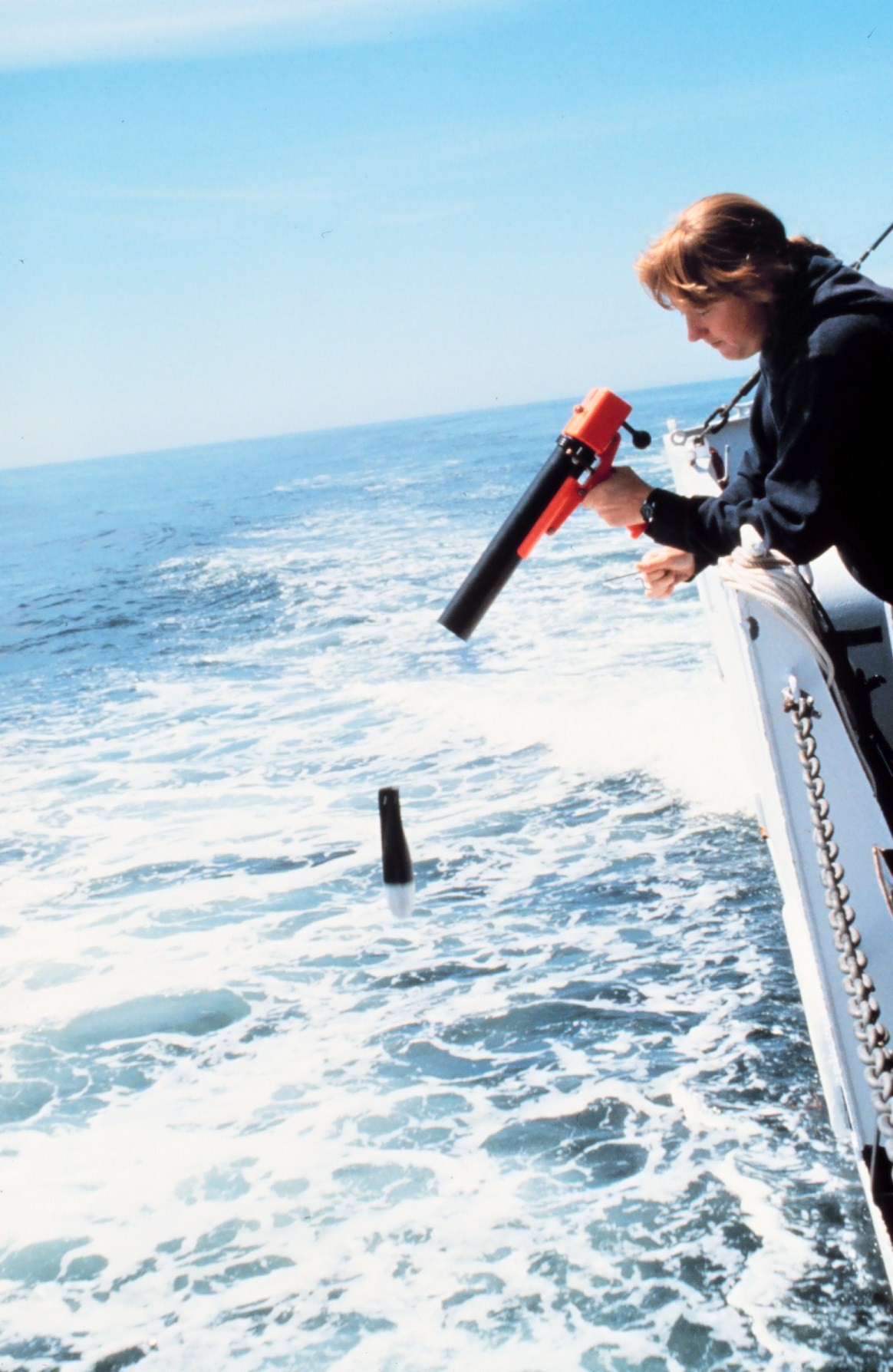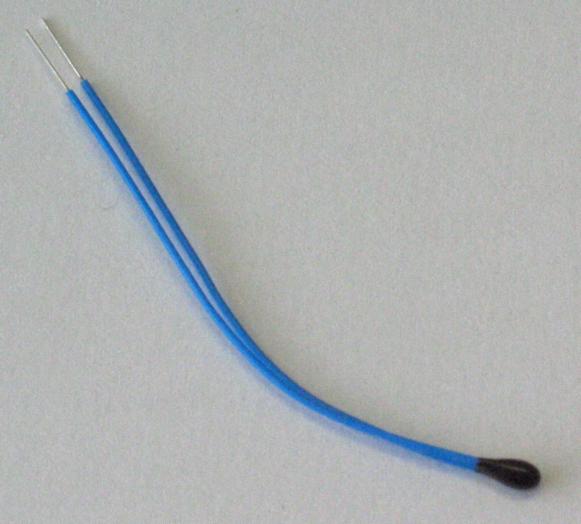|
Bathythermograph
The bathythermograph, or BT, also known as the Mechanical Bathythermograph, or MBT; is a device that holds a temperature sensor and a transducer to detect changes in water temperature versus depth down to a depth of approximately 285 meters (935 feet). Lowered by a small winch on the ship into the water, the BT records pressure and temperature changes on a coated glass slide as it is dropped nearly freely through the water. While the instrument is being dropped, the wire is paid out until it reaches a predetermined depth, then a brake is applied and the BT is drawn back to the surface. Because the pressure is a function of depth (see Pascal's law), temperature measurements can be correlated with the depth at which they are recorded. History The true origins of the BT began in 1935 when Carl-Gustaf Rossby started experimenting. He then forwarded the development of the BT to his graduate student Athelstan Spilhaus, who then fully developed the BT in 1938Scripps Institution of ... [...More Info...] [...Related Items...] OR: [Wikipedia] [Google] [Baidu] |
Athelstan Spilhaus
Athelstan Frederick Spilhaus (November 25, 1911 – March 30, 1998) was a South African-American geophysicist and oceanographer. Among other accomplishments, Spilhaus is credited with proposing the establishment of Sea Grant Colleges at a meeting of the American Fisheries Society in 1963 as a parallel to the successful land-grant colleges, which he claimed was "one of the best investments this nation ever made. The same kind of imagination and foresight should be applied to the exploration of the sea." Biography Spilhaus was born in 1911 in Cape Town, South Africa, grandson of the mathematician Thomas Muir. In 1936, Spilhaus joined the Woods Hole Oceanographic Institution in Massachusetts, where he developed the bathythermograph, which made the measurement of ocean depths and temperatures from a moving vessel possible, a device which proved indispensable to submarine warfare. This invention established his international reputation. He became a US citizen in 1946. Later, he ... [...More Info...] [...Related Items...] OR: [Wikipedia] [Google] [Baidu] |
CTD (instrument)
''For information about the CTD-rosette equipment package as a whole, see: Rosette sampler'' A CTD or sonde is an oceanography instrument used to measure the electrical conductivity, temperature, and pressure of seawater (the D stands for "depth," which is closely related to pressure). Conductivity is used to determine salinity. The CTD may be incorporated into an array of Niskin bottles referred to as a carousel or rosette. The sampling bottles close at predefined depths, triggered either manually or by a computer, and the water samples may subsequently be analyzed further for biological and chemical parameters. The CTD may also be used for the calibration of sensors. Measured properties The instrument is a cluster of sensors which measure conductivity, temperature, and pressure. Sensors commonly scan at a rate of 24 Hz. Depth measurements are derived from measurement of hydrostatic pressure, and salinity is measured from electrical conductivity. Sensors are arrang ... [...More Info...] [...Related Items...] OR: [Wikipedia] [Google] [Baidu] |
Thermocline
A thermocline (also known as the thermal layer or the metalimnion in lakes) is a thin but distinct layer in a large body of fluid (e.g. water, as in an ocean or lake; or air, e.g. an atmosphere) in which temperature changes more drastically with depth than it does in the layers above or below. In the ocean, the thermocline divides the upper mixed layer from the calm deep water below. Depending largely on season, latitude, and turbulent mixing by wind, thermoclines may be a semi-permanent feature of the body of water in which they occur, or they may form temporarily in response to phenomena such as the radiative heating/cooling of surface water during the day/night. Factors that affect the depth and thickness of a thermocline include seasonal weather variations, latitude, and local environmental conditions, such as tides and currents. Oceans Most of the heat energy of the sunlight that strikes the Earth is absorbed in the first few centimeters at the ocean's surface, whi ... [...More Info...] [...Related Items...] OR: [Wikipedia] [Google] [Baidu] |
Thermistor
A thermistor is a type of resistor whose resistance is strongly dependent on temperature, more so than in standard resistors. The word thermistor is a portmanteau of ''thermal'' and ''resistor''. Thermistors are divided based on their conduction model. Negative Temperature Coefficient (NTC) thermistors have ''less'' resistance at ''higher'' temperatures, while Positive Temperature Coefficient (PTC) thermistors have ''more'' resistance at ''higher'' temperatures. Hence, a PTC thermistor's resistance is directly proportional to temperature. NTC thermistor are widely used as inrush current limiters, temperature sensors, while PTC thermistors are used as self-resetting overcurrent protectors, and self-regulating heating elements. An operational temperature range of a thermistor is dependent on the probe type and is typically between −100 °C and 300 °C (−148 °F and 572 °F). Types Depending on materials used, thermistors are classified into two types: *With ''NTC'' th ... [...More Info...] [...Related Items...] OR: [Wikipedia] [Google] [Baidu] |
Oceanography
Oceanography (), also known as oceanology and ocean science, is the scientific study of the oceans. It is an Earth science, which covers a wide range of topics, including ecosystem dynamics; ocean currents, Wind wave, waves, and geophysical fluid dynamics; plate tectonics and the geology of the sea floor; and fluxes of various chemical substances and physical properties within the ocean and across its boundaries. These diverse topics reflect multiple disciplines that oceanographers utilize to glean further knowledge of the world ocean, including astronomy, biology, chemistry, climatology, geography, geology, hydrology, meteorology and physics. Paleoceanography studies the history of the oceans in the geologic past. An oceanographer is a person who studies many matters concerned with oceans, including marine geology, physics, chemistry and biology. History Early history Humans first acquired knowledge of the waves and currents of the seas and oceans in pre-historic times. Obser ... [...More Info...] [...Related Items...] OR: [Wikipedia] [Google] [Baidu] |
Conductivity (electrolytic)
Conductivity (or specific conductance) of an electrolyte solution is a measure of its ability to conduct electricity. The SI unit of conductivity is Siemens per meter (S/m). Conductivity measurements are used routinely in many industrial and environmental applications as a fast, inexpensive and reliable way of measuring the ionic content in a solution. For example, the measurement of product conductivity is a typical way to monitor and continuously trend the performance of water purification systems. In many cases, conductivity is linked directly to the total dissolved solids (TDS). High quality deionized water has a conductivity of about 0.05 μS/cm at 25 °C, typical drinking water is in the range of 200–800 μS/cm, while sea water is about 50 mS/cm ncorrect according to source(or 50,000 μS/cm). Conductivity is traditionally determined by connecting the electrolyte in a Wheatstone bridge. Dilute solutions follow Kohlrausch's Laws of conc ... [...More Info...] [...Related Items...] OR: [Wikipedia] [Google] [Baidu] |
Function (mathematics)
In mathematics, a function from a set to a set assigns to each element of exactly one element of .; the words map, mapping, transformation, correspondence, and operator are often used synonymously. The set is called the domain of the function and the set is called the codomain of the function.Codomain ''Encyclopedia of Mathematics'Codomain. ''Encyclopedia of Mathematics''/ref> The earliest known approach to the notion of function can be traced back to works of Persian mathematicians Al-Biruni and Sharaf al-Din al-Tusi. Functions were originally the idealization of how a varying quantity depends on another quantity. For example, the position of a planet is a ''function'' of time. Historically, the concept was elaborated with the infinitesimal calculus at the end of the 17th century, and, until the 19th century, the functions that were considered were differentiable (that is, they had a high degree of regularity). The concept of a function was formalized at the end of ... [...More Info...] [...Related Items...] OR: [Wikipedia] [Google] [Baidu] |
Argo (oceanography)
Argo is an international program that uses profiling floats to observe temperature, salinity, currents, and, recently, bio-optical properties in the Earth's oceans; it has been operational since the early 2000s. The real-time data it provides is used in climate and oceanographic research. A special research interest is to quantify the ocean heat content (OHC). The Argo fleet consists of almost 4000 drifting "Argo floats" (as profiling floats used by the Argo program are often called) deployed worldwide. Each float weighs 20–30 kg. In most cases probes drift at a depth of 1000 metres (the so-called parking depth) and, every 10 days, by changing their buoyancy, dive to a depth of 2000 metres and then move to the sea-surface, measuring conductivity and temperature profiles as well as pressure. From these, salinity and density can be calculated. Seawater density is important in determining large-scale motions in the ocean. Average current velocities at 1000 ... [...More Info...] [...Related Items...] OR: [Wikipedia] [Google] [Baidu] |
Atlantic Oceanographic And Meteorological Laboratory
The Atlantic Oceanographic and Meteorological Laboratory (AOML), a federal research laboratory, is part of the National Oceanic and Atmospheric Administration's (NOAA) Office of Oceanic and Atmospheric Research (OAR), located in Miami in the United States. AOML's research spans tropical cyclone and hurricanes, coastal ecosystems, oceans and human health, climate studies, global carbon systems, and ocean observations. It is one of seven NOAA Research Laboratories (RLs). AOML’s organizational structure consists of an Office of the Director and three scientific research divisions. The Office of the Director oversees the Laboratory’s scientific programs, as well as its financial, administrative, computer, outreach/education, and facility management services. Research programs are augmented by Cooperative Institutes, such as the Cooperative Institute for Marine and Atmospheric Studies (CIMAS), a joint enterprise with the University of Miami’s Rosenstiel School of Marine, At ... [...More Info...] [...Related Items...] OR: [Wikipedia] [Google] [Baidu] |





